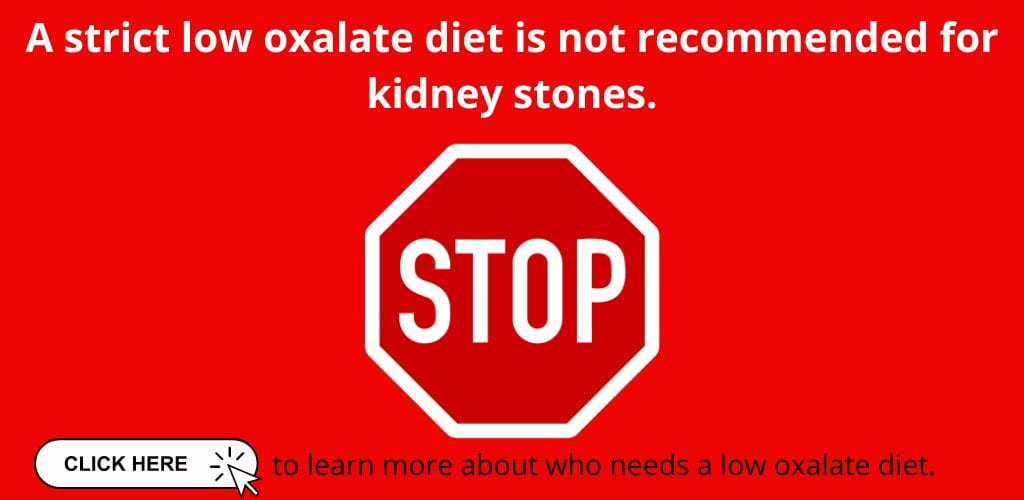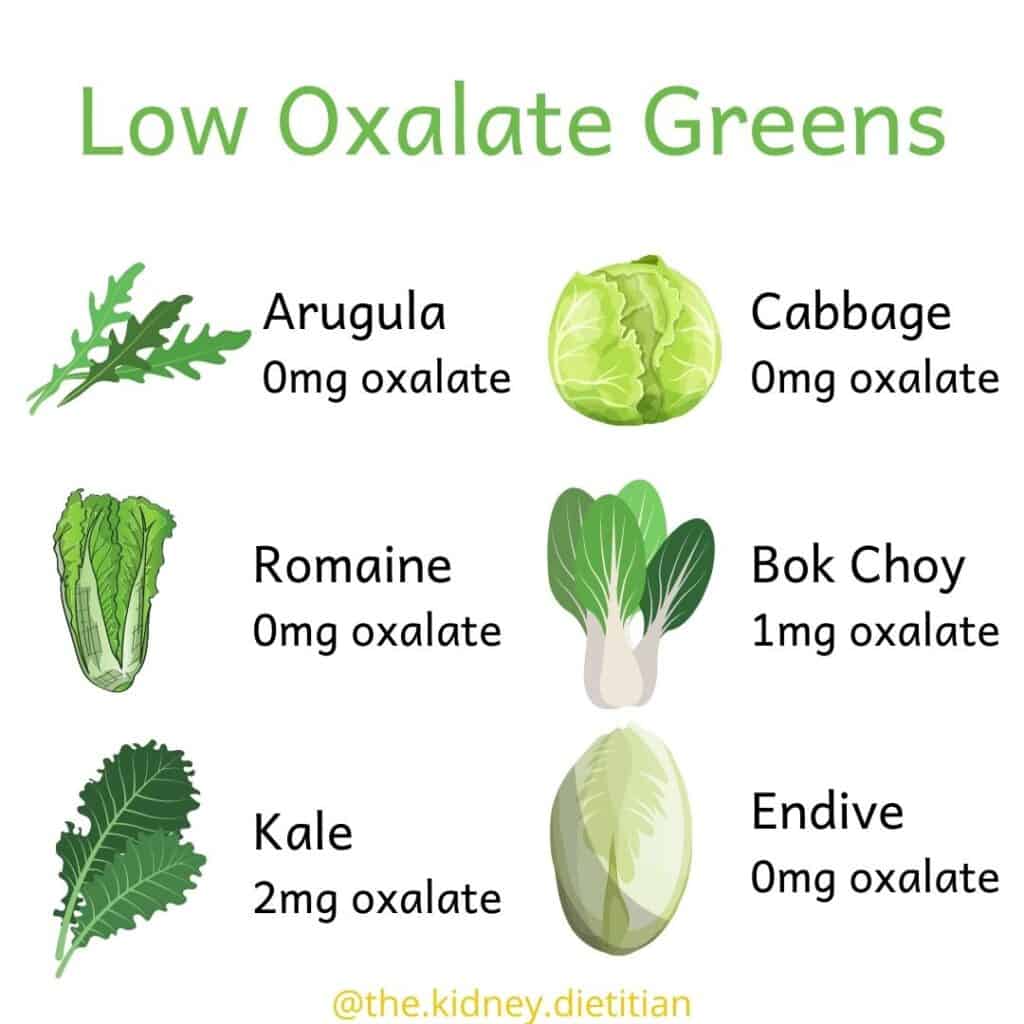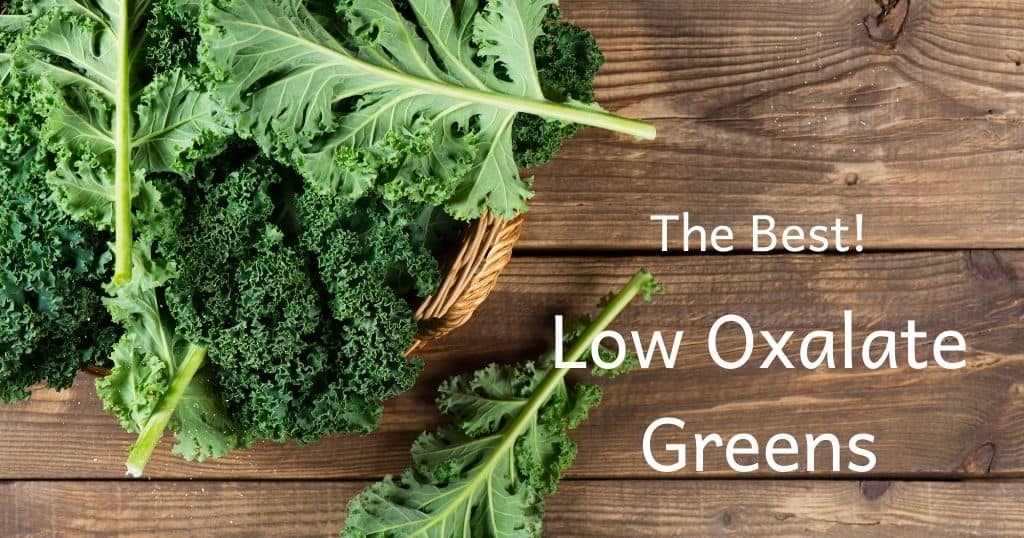Yes! Low oxalate greens do exist. Unfortunately, many people are given general advice to “avoid all green vegetables” on a low oxalate diet. But, this is just simply lazy and false information. There are plenty of low oxalate greens that can (and should!) be eaten on a healthy low oxalate diet.

Table of Contents
Who Needs Low Oxalate Greens?
I always like to add this (strong!) disclaimer to all of my information about low oxalate foods. Not everyone with kidney stones needs a low oxalate diet. In fact, not even everyone with oxalate kidney stones needs a low oxalate diet.
Only people with high urine oxalate need to follow a low oxalate diet. Hint: the most common cause of calcium oxalate stones is high urine calcium, not high urine oxalate.
In fact, the American Urological Association recommends that people with high urine oxalate limit how much oxalate they eat. (1) A 24 hour urine test is the only way to know if your urine oxalate is high.
If you do need a low oxalate diet, then choosing low oxalate greens is a key part of healthy eating for you!
It is very important to know that oxalate is only a piece of the puzzle. Learn more about all aspects of your diet that can impact calcium oxalate kidney stones.
High Oxalate Greens
Honestly, the list of high oxalate greens is much shorter than the list of low oxalate greens. However, these high oxalate greens are very high in oxalate. So, it is important to know about them if you need a low oxalate diet.
For example, raw spinach has around 656mg oxalate per cup. This is more than 40x higher than most other vegetables.
High oxalate greens:
- Spinach (656mg oxalate per 1 cup, raw)
- Chard (350mg oxalate per 1 cup, raw)
What Is a Low Oxalate Green?
There is no official definition of a low oxalate green. In fact, there is no definition or cut-off for what a low oxalate food is.
This is complicated by the fact that there isn’t an official definition of what a “low oxalate diet” is either. There isn’t an official amount of oxalate you should eat per day for a low oxalate diet. Instead, the amount of oxalate that is right for you should be individualized to your 24-hour urine results. Ideally, by a Registered Dietitian who takes the amount of calcium and your other kidney stone risk factors into account.
For most people with high urine oxalate, I recommend an oxalate amount of around 100mg per day. So, I used a definition for low oxalate greens to be any green with 10mg or less of oxalate per serving.
Top 10 Low Oxalate Greens
Here is the good stuff! These are my favorite low oxalate greens for people who have high urine oxalate.
Arugula
0mg oxalate per 1 cup
Probably my favorite low oxalate green, arugula is tasty in salads or as a topping for pizza and flatbreads. It is one of my go-to toppings for avocado toast.
I even love to sauté arugula for about 1 minute to wilt it just a bit and mix it into scrambled eggs and omelets.
Romaine Lettuce
0mg oxalate per 1 cup
Classic and crunchy! I love to mix some romaine lettuce into my salads for that crunch. It is the base of my Tomato & Mozzarella Salad!
Iceberg Lettuce
0mg oxalate per 1 cup
Iceberg lettuce gets a bad rap for having no nutrition. But, I beg to differ. It is a great source of fiber and water (which just happens to be critical for kidney stone prevention).
Plus, it is very low in oxalate!

Kale
2mg oxalate per 1 cup
Yep! Kale is surprisingly low in oxalate. Kale is a great low oxalate green substitute for spinach in salads and other recipes.
Cabbage
0mg oxalate per 1 cup
All kinds of cabbage are low in oxalate. Savoy, Napa and purple cabbage are all low oxalate.
I think cabbage is one of the most under-rated vegetables. It is just so versatile! Sautéed cabbage is an excellent side dish for pretty much any entrée. Also, who doesn’t love a crunchy cabbage slaw on top of fish tacos?
Mustard, Turnip and Collard Greens
4-10mg oxalate per 1 cup
Yet another surprising low oxalate green, greens such as mustard, turnip and collard greens are a great option!
Check out this lower sodium traditional Southern Collard Greens recipe! Or, you can eat greens raw like this Mustard Greens Salad with Apples and Dill. Yum!
Bok Choy
1mg oxalate per 1 cup
Bok choy is a great way to mix up your veggies. Chop it up and mix it into your favorite stir fry.
Or, Bok choy is a great low oxalate side dish. This Lemon Garlic Sautéed Bok Choy is delightfully tasty and easy!
Watercress
0mg oxalate per 1 cup
Watercress is another lesser utilized low oxalate green – coming in at ZERO oxalate.
Watercress is delicious raw in salads or cooked! Give this Gingered Watercress a try.
Butter Lettuce
5mg oxalate per 1 cup
Butter lettuce is another low oxalate green to add to your rotation. It adds a bright green color and a soft (buttery, if you will!) texture to salads.
Endive
0mg oxalate per 1 cup
Endive is our last low oxalate green. It is delicious cooked (try this Braised Endive) or raw.
This low oxalate green makes adorable bite-sized appetizers. Stuff endive with a tasty filling like blue cheese and apples!
Other Low Oxalate Green Vegetables
Other than low oxalate greens, there are plenty of other green vegetables you can enjoy on a low oxalate diet!
Here are some of my favorites:
All oxalate amounts based on 1 cup raw vegetable, unless otherwise specified
- Green Peas (1 mg)
- Zucchini (1mg)
- Green Onions (0.5mg per 2 stalks)
- Broccoli (2mg)
- Celery (5mg)
- Asparagus (6mg per 4 spears)
- Green Bell Peppers (10mg)
- Brussels Sprouts (4mg)
- Cucumbers (2mg)
Happy Eating!
Melanie



how about barley green powder and sunchlorella and miners lettuce
I don’t know of an accurate oxalate count for any of these foods.
I have read that eating calcium with meals will help the Oxilate bind to calcium and will be excreted by intestines and not travel to kidneys to crystallize. Is this true?
Yep! This is very true. I talk more about this here.
Thank you so much for this list. Guinea pigs need low oxalate or they get bladder stones. I needed a low leafy green list. thanks
Thank you for this great article, Melanie! I’ve been looking for some additional green veggies that are low-oxalate friendly.
oops, it looks like I re-sourced you (The Kidney Dietician) for the Butter Lettuce oxalate level. LOL
I am confused by the amount of oxalates in Butter Lettuce. You list it as having 5 g. If I convert that to mgs, then the amount of oxalates is 5,000mg of oxalates in 1 cup of butter lettuce which seems extremely high and should be listed in the “High Oxalate” list. I did a search and found only one reference for Butter Lettuce which also listed it as having 5 grams of oxalates (The Kidney Dietician.org). I like Butter lettuce and would like to continue to eat it, however I need to severely restrict my oxalate intake.
Whoops! This is a typo. It should read “5mg” (not grams!). This has been changed.
Hello, I’m not at risk for kidney stones, but I’d like to use high-oxalate foods in moderation because I am at risk for osteoporosis. I do eat a lot of greens because I enjoy them and they have many health benefits. I have some cardoon growing in a pot that I enjoy harvesting. Cardoon is basically an artichoke relative that is not very good at making artichokes. It is harvested for the leaf ribs, which are used like celery and taste a bit like artichoke. Some people also eat the leaves, which are very bitter. I’ve enjoyed the leaves before, but I’d like to know how careful I should be about limiting amounts of these leaves, in terms of oxalate content. I haven’t found any data. A similar- tasting relative is called African Bitter Leaf. Both cardoon and the bitter-leaf are distant relatives of lettuce. I believe I may have read somewhere that another lettuce relative, dandelion, has more oxalic acid after it flowers. Do you have any ideas about either of these? Thank you for your blog!
Hello! There is actually NO reason to avoid oxalate for bone health or osteoporosis. Oxalate would likely reduce the gastrointestinal availability of calcium. BUT, we only absorb about 30% of calcium from our food anyway. And, our bodies are SUPER good at adjusting how much calcium we absorb from our food based on how much we need. Plus, there is not a shred of evidence that a low oxalate diet would benefit people with osteoporosis. So, I truly wouldn’t worry about any of this!
Hi. I am a bit confused. You say in the article that “ the most common cause of calcium oxalate stones is high urine calcium, not high urine oxalate.” you mention in the comments that you need a high calcium diet to prevent forming oxalate stones. But if you eat a high calcium diet, you will have high urine calcium, which as you mentioned I. The article is the most common cause of oxalate stones. What am I missing?
Thanks,
Gabriela
Eating a diet adequate in calcium doesn’t raise urine calcium much – but does drastically reduce urine oxalate levels. I discuss this more here!
Is it even necessary to avoid oxalates? I have a friend who has had recurring stones insist that as long as he keeps himself well hydrated and gets enough calcium,he’s able to remain virtually stone-free despite consuming high-oxalate foods
For many people it isn’t necessary to avoid oxalate! It 100% depends on their 24-hour urine test!
What’s the 24 hour urine test ?
Here is a post to learn more!
Hi Carol
Thanks for your web site.
I visited many website. They all have conflicting oxalate amounts.
what authoritative source(s) did you use?
Did you use the Centers for Disease Control and Prevention or NIH?
or some Kidney association?
Thanks for your help, since I cannot believe and web site oxalate amounts.
Ron
Hi Ron –
I use the Harvard oxalate list whenever possible. After that, I rely on data from the NCCDB.
What do you know about the amount of oxalates in the LEAVES of zucchini.
and Where is the a comprehensive list. I tired Centers for Disease Prevention and Control and got now response, Likewise with kidney foundations.
Hi Ron! I don’t have an accurate count for zucchini leaves. But they are likely on the lower side given zucchini is lower in oxalate. Here is a link to get my oxalate list based on Harvard data. But, I HIGHLY discourage counting how much oxalate you eat because it would be nearly impossible to do. It is also 100% unnecessary. Some people might need to avoid those foods very high in oxalate, but for the vast majority of people, simply getting in enough calcium is enough to get urine oxalate levels into the normal range. Hope that helps!
what about my beloved keto cookies i thought i could enjoy? i make them with almond flower and a very small amt of coconut sugar . i eat one or two very small. is this a “no” for osteoporosis? would cocoanut flour be better?
thank you
There is no connection between osteoporosis and oxalate! However, I ALWAYS recommend if you want a cookie, just eat the real thing!
I need a low to moderate oxalate diet due to chronic inflamation., and kidney stones, any help coordinating these would be helpful. thanks so much.
Hi Carol! Here is an article about who needs to follow a low oxalate diet. There is actually no data to show a low oxalate diet would help with inflammation.
Hi – from what I’ve found googling, which was only a single unsourced reference, it looks like raw fennel (as in those big fennel bulbs) is low in oxalate. Do you agree? Though fennel seeds seem to have a lot of oxalate.
My sources say similarly for raw fennel. Here are my thoughts on oxalate in spice!
Ok, thanks.